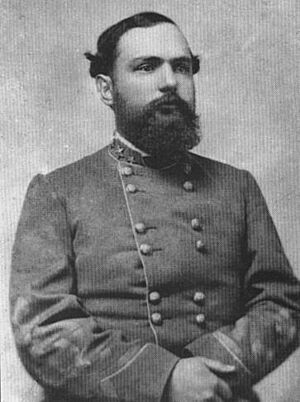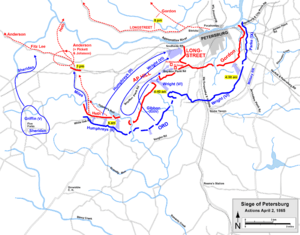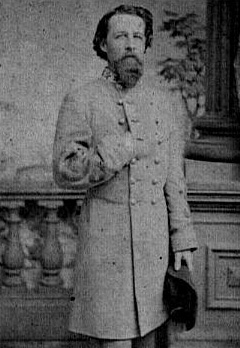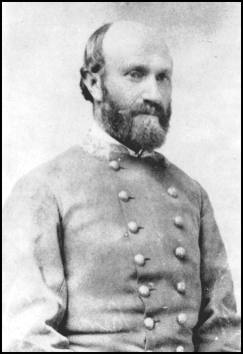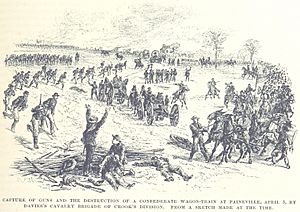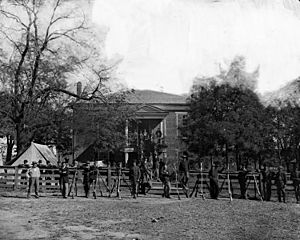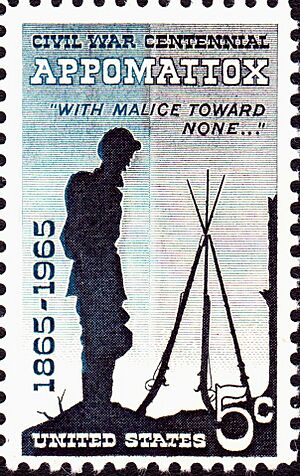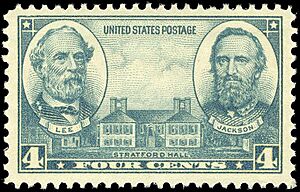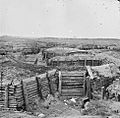Appomattox campaign facts for kids
Quick facts for kids Appomattox campaign |
|||||||
|---|---|---|---|---|---|---|---|
| Part of the Eastern Theater of the American Civil War | |||||||
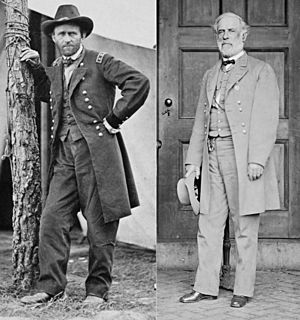 Ulysses S. Grant and Robert E. Lee, opposing commanders in the Appomattox campaign |
|||||||
|
|||||||
| Belligerents | |||||||
| Commanders and leaders | |||||||
| Ulysses S. Grant Thomas M. Harris George G. Meade Edward Ord Philip Sheridan |
Robert E. Lee |
||||||
| Units involved | |||||||
| Army of Northern Virginia | |||||||
| Strength | |||||||
| 114,335 | 56,000 | ||||||
| Casualties and losses | |||||||
| 10,780 | ~25,000; Army of Northern Virginia disbanded following Gen. Lee's surrender at Appomattox Court House (April 9). | ||||||
The Appomattox campaign was a series of important battles during the American Civil War. These battles took place from March 29 to April 9, 1865, in Virginia. The campaign ended when Confederate General Robert E. Lee and his Army of Northern Virginia surrendered to Union Lieutenant General Ulysses S. Grant. This surrender effectively marked the end of the Civil War.
Before this campaign, Lee's army was tired and outnumbered. They had spent a long winter fighting in trenches during the Richmond–Petersburg campaign. Grant's Union army, however, was strong and well-supplied. On March 29, 1865, the Union army launched a big attack. They broke through the Confederate defenses near Petersburg and cut off their supply lines to Petersburg and the Confederate capital, Richmond.
Key Union victories at the Battle of Five Forks on April 1 and the Third Battle of Petersburg on April 2 opened the way for the Union to capture Petersburg and Richmond. Lee quickly ordered his troops to leave both cities on the night of April 2–3. Confederate government leaders also fled Richmond that same night.
The Confederates marched west, hoping to get supplies at cities like Lynchburg, Virginia. Lee planned to then move southwest into North Carolina to join another Confederate army led by General Joseph E. Johnston. But Grant's Union army chased Lee's troops without stopping. Over the next week, Union soldiers fought many battles, destroyed Confederate supplies, and blocked their escape routes. On April 6, 1865, the Confederates suffered a major loss at the Battle of Sailor's Creek, losing about 7,700 men. Finally, Lee's army was trapped, low on food, and greatly outnumbered. He surrendered his Army of Northern Virginia to Grant on April 9, 1865, at the McLean House near Appomattox Court House, Virginia.
Contents
- Why the Campaign Happened
- Key Battles and Movements
- The Confederate Retreat Continues
- What Happened Next
- How Historians Classify These Events
- Images for kids
Why the Campaign Happened
The Armies' Positions
After earlier battles, Union forces had most of Lee's army stuck in trenches around Richmond and Petersburg. But the Union army wasn't strong enough to completely surround the Confederates or cut off all their supplies. The smaller Confederate army could defend its positions but couldn't launch a big attack to push the Union forces away.
Grant's Plan
Grant's main goal was to cut off all supplies to Petersburg and Richmond. This would force the Confederate army to spread its defenses even thinner. Grant launched several attacks in late 1864 and early 1865. He slowly extended the Union lines westward, forcing Lee to stretch his own defenses. This made the Confederate lines very weak.
Lee's Plan to Leave Petersburg
After the Battle of Hatcher's Run in February 1865, Lee knew his army couldn't keep extending its lines. He expected Grant to keep pushing. Lee decided his army had to break out of the Richmond and Petersburg defenses. He wanted to get food and supplies at Danville or Lynchburg, Virginia. Then, he hoped to join General Joseph E. Johnston's army in North Carolina.
Lee also considered a surprise attack on the Union lines at Fort Stedman. He hoped this would damage Grant's supply lines and make Grant shorten his own lines. This would give Lee a chance to move his army. But the attack on Fort Stedman on March 25, 1865, failed badly. The Union forces quickly fought back, recapturing the fort and causing heavy losses for the Confederates. This defeat showed Lee that he couldn't afford to split his army.
Grant's Orders for a Big Attack
On March 24, 1865, Grant ordered a major attack to begin on March 29. He wanted Major General Philip Sheridan's cavalry to cut the remaining Confederate railroads. These were the Southside Railroad to Petersburg and the Richmond and Danville Railroad to Richmond. Grant also wanted his infantry to support Sheridan and stop the Confederates from escaping west.
Key Battles and Movements
Moving West: March 29–30
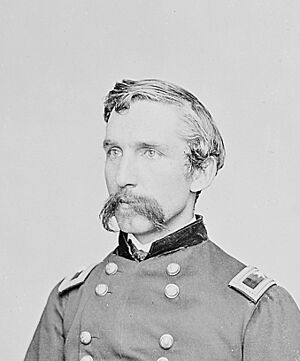
On March 29, Union troops began moving south and west. Their goal was to cut the Confederate supply lines and get around their right side. At Lewis's Farm, Union soldiers led by Brigadier General Joshua Chamberlain met Confederate troops. After a tough fight, the Union forces pushed the Confederates back.
Later that day, Sheridan's cavalry took over Dinwiddie Court House without a fight. This put Union forces in a strong position to attack Five Forks, a very important road junction. Taking Five Forks would mean cutting the last railroad lines to Petersburg and Richmond. Grant saw this opportunity and decided to make it a major offensive to end the war.
Heavy rain started on March 29 and continued through March 30. This made it hard for the armies to move. Lee realized the danger and moved more troops to defend his far right flank. He also sent Major General George Pickett and his infantry to Five Forks to join the cavalry there.
White Oak Road: March 31
On the morning of March 31, General Lee saw a weak spot in the Union line. He ordered an attack on the exposed Union troops. Confederate brigades attacked two Union divisions, pushing them back. Union General Gouverneur K. Warren tried to rally his men but had to retreat.
However, Union reinforcements arrived and stopped the Confederate advance. After regrouping, Union forces counterattacked. They pushed the Confederates back to their original defenses. The Union army gained control of a part of White Oak Road, cutting off direct communication between Confederate forces.
Dinwiddie Court House: March 31
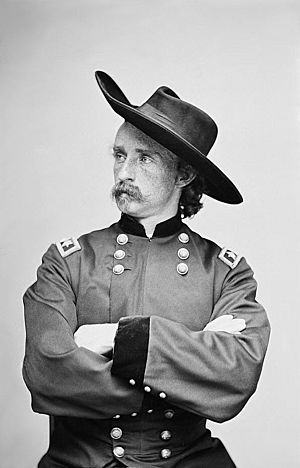
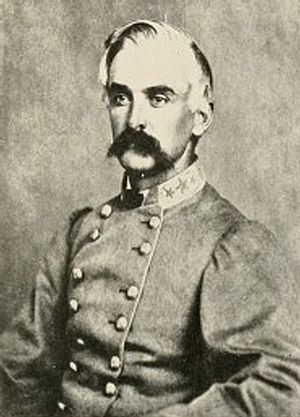
On March 29, Sheridan's cavalry entered Dinwiddie Court House. On March 30, they skirmished with Confederate cavalry. That night, Major General George Pickett arrived at Five Forks with infantry and took command of the Confederate forces there.
On March 31, in the continuing rain, Pickett launched an attack on Sheridan's cavalry. The Confederates tried to get around the Union left side. Union cavalry, armed with repeating rifles, fought hard. They held off the Confederates through a series of delaying actions. As darkness fell, both armies stayed in position, planning to fight again in the morning.
During the night, Union General Warren's infantry corps arrived to support Sheridan. Grant officially put Warren's corps under Sheridan's command. Pickett, realizing Union infantry were nearby, pulled his troops back to Five Forks.
Five Forks: April 1

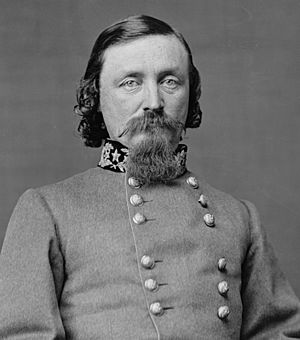

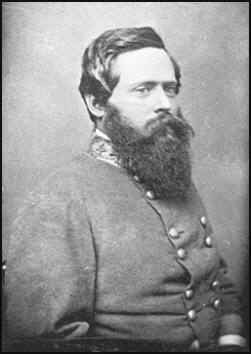
The Battle of Five Forks on April 1, 1865, was a very important battle. It took place at the Five Forks crossroads, which was key to controlling the South Side Railroad. Union forces, led by Major General Philip Sheridan and Major General Gouverneur K. Warren, attacked the Confederates.
The Union cavalry attacked the front and right side of the Confederate line. This kept the Confederates busy while the Union infantry prepared to attack their left side. Pickett and Fitzhugh Lee were away from the battlefield, having lunch, and didn't know the attack was starting. By the time they returned, their lines were already falling apart.
The Union infantry attacked the Confederate left flank, rolling up their lines. Sheridan personally led his men, encouraging them. The Union cavalry also pushed the Confederate cavalry back. Most of the Confederate infantry were captured or killed. The Union army won a decisive victory, taking over 1,000 Confederate casualties and at least 2,400 prisoners. They now controlled Five Forks and the road to the South Side Railroad.
After the battle, Sheridan unfairly removed Warren from command, even though Warren had fought bravely. Grant learned of the victory and ordered a general attack along the Confederate lines around Petersburg for the next morning.
Breakthrough at Petersburg: April 2
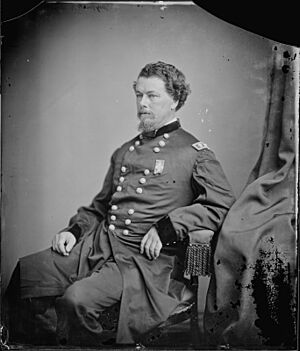
On April 2, Union artillery began firing on the Confederate lines at 10:00 p.m. and continued until 2:00 a.m. Major General Horatio Wright's VI Corps attacked the Confederate line. They overwhelmed the Confederate pickets and quickly broke through the main defenses. Within about 30 minutes, the Union VI Corps had made a decisive breakthrough. Some Union soldiers even reached the South Side Railroad.
A.P. Hill Killed
Confederate Lieutenant General A. P. Hill rode to the front lines to organize a defense. He encountered two Union soldiers, who shot and killed him. This was a significant loss for the Confederates.
Forts Gregg and Whitworth
As the Union forces advanced, Confederates tried to hold them back at Forts Gregg and Whitworth. About 350 Confederate defenders held Fort Gregg against 4,000 Union attackers. The Union soldiers faced intense fire and struggled to cross a ditch around the fort. Eventually, they found a weak spot and stormed the fort, capturing the remaining defenders after fierce hand-to-hand combat. Fort Whitworth fell soon after. These battles bought Lee some valuable time, allowing more Confederate troops to reach new defensive lines.
Lee Decides to Retreat
After the Union breakthrough, Lee told the Confederate government to leave Petersburg and Richmond. His plan was to move his army across the Appomattox River and meet at Amelia Court House. There, they hoped to get supplies and then move south to join General Joseph Johnston's army in North Carolina. After dark, Lee began evacuating his troops from Petersburg and Richmond. The city of Richmond was set on fire as the Confederate government fled.
Sutherland's Station: April 2

The Battle of Sutherland's Station was fought west of Petersburg. Union Major General Nelson A. Miles's division pursued retreating Confederates. The Confederates, led by Brigadier General John Rogers Cooke, set up a defensive line. Miles's troops attacked several times and were pushed back. Finally, a strong Union attack broke the Confederate line. The Union forces captured 600 prisoners and two cannons. The South Side Railroad, the last Confederate supply line to Petersburg, was now cut.
Union Takes Richmond and Petersburg: April 3
Union troops entered and occupied Richmond and Petersburg on April 3. They began putting out fires and restoring order. President Lincoln met with Union generals in Petersburg. Confederate President Jefferson Davis and most of his government reached Danville, Virginia.
Lincoln Visits Richmond: April 4
President Lincoln visited Richmond, escorted by naval officers. Many African-Americans greeted him with joy. Lincoln met with Union generals and even sat at Jefferson Davis's old desk in the Confederate White House.
The Confederate Retreat Continues
Namozine Church: April 3
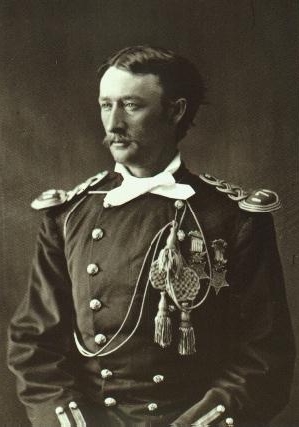
As Confederate forces moved toward Amelia Court House, Union cavalry pursued them. On April 3, Union cavalry, including units led by Captain Thomas Custer (General Custer's brother), fought with Confederate rear guard cavalry. Captain Custer bravely captured Confederate officers and a battle flag, earning the Medal of Honor. The Confederate cavalry managed to hold off the Union troops long enough for their infantry to pass.
Amelia Court House: April 4
Lee had expected to find food for his army at Amelia Court House, but there was very little. He had to wait for his army to gather and sent out foraging parties, but they found few supplies. This delay was critical. Union cavalry and infantry quickly moved to Jetersville, southwest of Amelia Court House, blocking Lee's escape route along the railroad. Lee's only option now was a long march west to Lynchburg, hoping to find supplies there.
Paineville; Amelia Springs: April 5–6
On April 5, Union cavalry found and attacked a Confederate wagon train carrying food and supplies for Lee's army. The Union troops burned many wagons, captured horses, mules, artillery, and 630 prisoners. Confederate cavalry fought back, leading to a running battle. The Union forces managed to return with their prisoners and captured goods.
Lee realized his route to Danville was blocked. His only remaining option was to march west to Lynchburg.
Sailor's Creek: April 6
On April 6, the Battle of Sailor's Creek was a major disaster for the Confederates. Union forces attacked different parts of Lee's retreating army. Between one-fifth and one-fourth of the remaining Confederate army was captured or became casualties, about 8,000 men. This included many Confederate generals.
When General Lee saw the chaos and survivors streaming away, he famously said, "My God, has the army dissolved?" This battle severely weakened Lee's army.
High Bridge: April 6–7
At the first Battle of High Bridge on April 6, Confederates stopped Union raiders from burning a key bridge. This allowed Confederate troops to cross the Appomattox River. Many Union soldiers were captured.
On April 7, after most of Lee's army had crossed, the Confederate rear guard tried to burn the bridges. But Union troops managed to put out the fires on two bridges and crossed the river. They caught up with the Confederates at Farmville. Lee's cavalry held off the Union infantry until nightfall, but Lee was forced to keep marching, losing the chance to get food at Farmville.
Farmville: April 7
Confederate forces held off the Union advance near Farmville, crossed the Appomattox River, and continued their retreat. That night, Grant sent Lee a letter suggesting surrender. Lee, still hoping to reach Appomattox Station for supplies, sent a noncommittal reply.
Cumberland Church: April 7
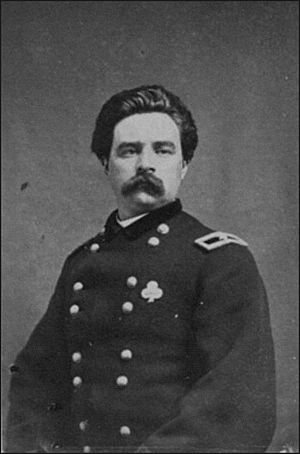
Union forces attacked Confederate positions near Cumberland Church but were pushed back. Union Brigadier General Thomas Alfred Smyth was mortally wounded, becoming the last Union general killed in the war.
Appomattox Station: April 8
Union cavalry, led by Brigadier General George Armstrong Custer, seized a Confederate supply train and 25 cannons at Appomattox Station. Custer's men captured and burned three trains full of food for Lee's army. This effectively blocked Lee's path. With no supplies left, Lee's last hope was to outmarch the Union forces to Lynchburg. Grant sent another letter to Lee, offering generous surrender terms and proposing a meeting.
Appomattox Court House: April 9

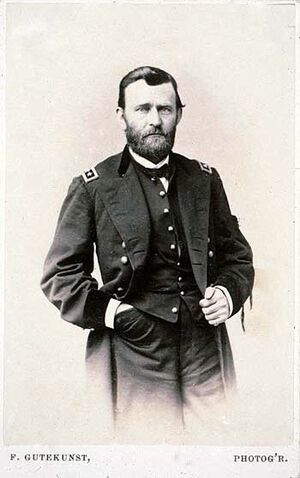

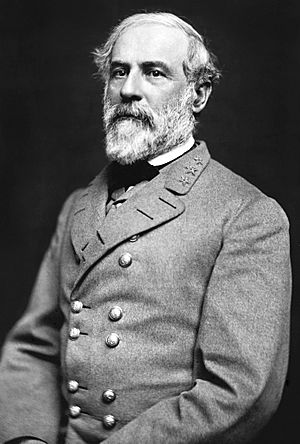
At dawn on April 9, 1865, the Confederate army launched a final attack. They pushed back the first Union lines. But as they reached a ridge, they saw a huge Union force waiting. Lee's outnumbered army was now surrounded on three sides. Lee's cavalry managed to escape, but the infantry was trapped.
Lee's staff told him the situation was hopeless. Lee finally said, "Then there is nothing left for me to do but to go and see General Grant and I would rather die a thousand deaths." Lee surrendered his army at 3 p.m. at the McLean House.
Grant offered very generous terms. Lee's men would not be imprisoned or charged with treason. Officers could keep their sidearms. Grant also allowed the defeated soldiers to take their horses and mules home for spring planting. He even provided food for Lee's starving army. Lee said these terms would help bring the country back together. Grant's Native American adjutant, Ely S. Parker, wrote down the surrender terms.
What Happened Next
The Appomattox campaign showed Grant and Sheridan's amazing skill in chasing and outmaneuvering the enemy. Lee did his best, but his supplies, soldiers, and luck finally ran out. Lee's surrender was a huge blow to the South. Even though other Confederate armies were still fighting, they soon gave up by June 1865.
It's hard to know the exact number of Confederate casualties because many records were lost. But estimates suggest about 6,266 killed and wounded, and 19,132 captured. About 22,349 infantry, 1,559 cavalry, and 2,576 artillery troops surrendered at Appomattox Court House. Many Confederate veterans later said there were only "8,000 muskets" left, but this number doesn't include cavalry and artillery. Union casualties for the campaign were about 9,700 killed, wounded, or missing.
How Historians Classify These Events
Historians sometimes disagree on where one military campaign ends and another begins. This article uses the way the U.S. National Park Service classifies these battles.
Another way of classifying them is used by West Point. They say the siege of Petersburg ended with the Union attack on April 2. The rest of the war in Virginia is called "Grant's Pursuit of Lee to Appomattox Court House (April 3–9, 1865)."
Some historians also believe the Battle of Lewis's Farm should be seen as the first battle of what they call the "Five Forks Campaign."
Images for kids


